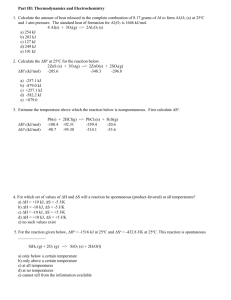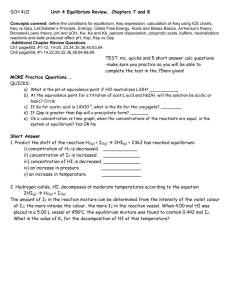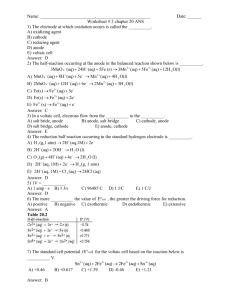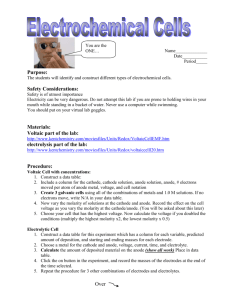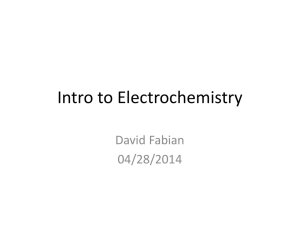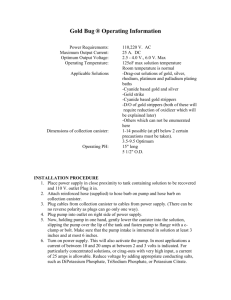fin03example
advertisement
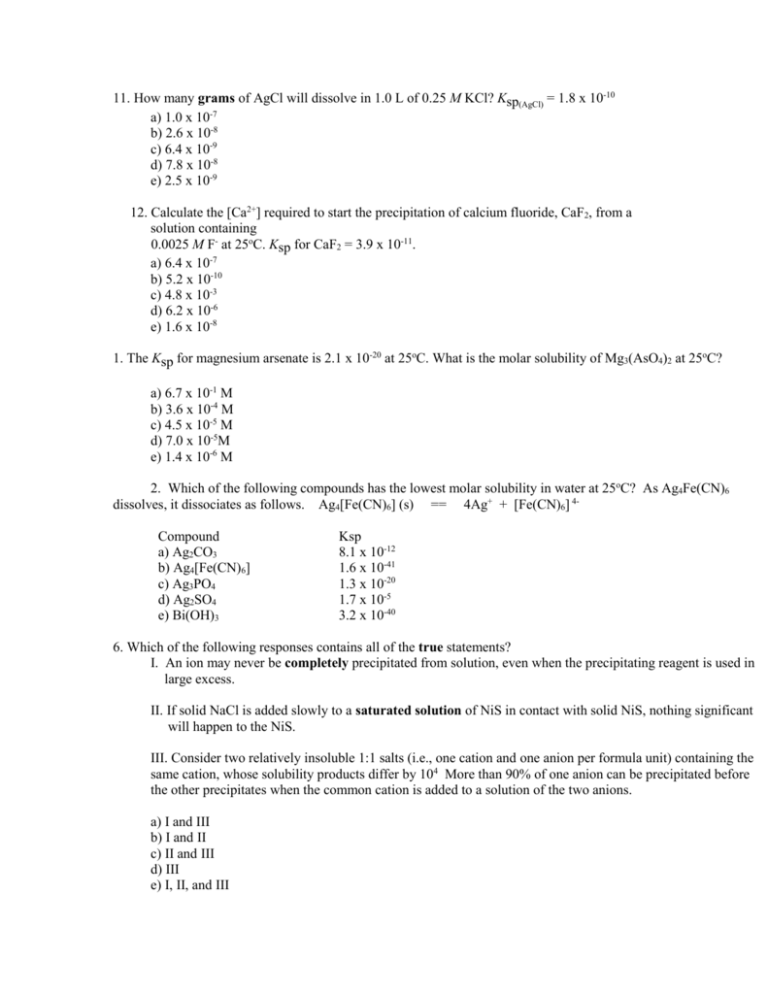
11. How many grams of AgCl will dissolve in 1.0 L of 0.25 M KCl? Ksp(AgCl) = 1.8 x 10-10 a) 1.0 x 10-7 b) 2.6 x 10-8 c) 6.4 x 10-9 d) 7.8 x 10-8 e) 2.5 x 10-9 12. Calculate the [Ca2+] required to start the precipitation of calcium fluoride, CaF2, from a solution containing 0.0025 M F- at 25oC. Ksp for CaF2 = 3.9 x 10-11. a) 6.4 x 10-7 b) 5.2 x 10-10 c) 4.8 x 10-3 d) 6.2 x 10-6 e) 1.6 x 10-8 1. The Ksp for magnesium arsenate is 2.1 x 10-20 at 25oC. What is the molar solubility of Mg3(AsO4)2 at 25oC? a) 6.7 x 10-1 M b) 3.6 x 10-4 M c) 4.5 x 10-5 M d) 7.0 x 10-5M e) 1.4 x 10-6 M 2. Which of the following compounds has the lowest molar solubility in water at 25oC? As Ag4Fe(CN)6 dissolves, it dissociates as follows. Ag4[Fe(CN)6] (s) == 4Ag+ + [Fe(CN)6] 4Compound a) Ag2CO3 b) Ag4[Fe(CN)6] c) Ag3PO4 d) Ag2SO4 e) Bi(OH)3 Ksp 8.1 x 10-12 1.6 x 10-41 1.3 x 10-20 1.7 x 10-5 3.2 x 10-40 6. Which of the following responses contains all of the true statements? I. An ion may never be completely precipitated from solution, even when the precipitating reagent is used in large excess. II. If solid NaCl is added slowly to a saturated solution of NiS in contact with solid NiS, nothing significant will happen to the NiS. III. Consider two relatively insoluble 1:1 salts (i.e., one cation and one anion per formula unit) containing the same cation, whose solubility products differ by 104 More than 90% of one anion can be precipitated before the other precipitates when the common cation is added to a solution of the two anions. a) I and III b) I and II c) II and III d) III e) I, II, and III 10. The half-reaction that occurs at the cathode during the electrolysis of molten sodium bromide is ________________________. a) 2Br- --> Br2 + 2eb) Br2 + 2e- --> 2Brc) Na+ + e- --> Na d) Na --> Na+ + ee) 2H2 O + 2e- --> 2OH- + H2 11. Balance the following redox reaction: Cr2O72- + S2O32- --> Cr3+ + S4O62- 12. Given the standard electrode potentials below, calculate Kc at 25oC for the following reaction. (F = 96,500 coul/Far and R = 8.314 J/mol K) 2Fe3+ (aq) + 2I- (aq) --> 2Fe2+ (aq) + I2 (s) Eo Fe3+ (aq) + e- --> Fe2+ (aq) +0.771 V I2 (s) + 2e --> 2I- (aq) +0.535 V a) b) c) d) e) 1.6 x 1012 1.1 x 10-8 1.0 x 10-4 9.6 x 1017 9.7 x 103 13. Calculate Ecell for the following voltaic cell. Ag | Ag+(1.0 x 10-5 M) || Au3+ (1.0 x 10-1 M) | Au a) +0.78 V b) +0.46 V c) +0.88 V d) +0.98 V e) +2.58 V 14. Calculate the Gibbs free energy change for the reaction below when initial concentrations of Cr3+ and Cu2+ are 1.00 M. (F = 96,500 coul/Far) 2 Cr3+ (aq) + 3Cu(s) --> 2Cr(s) + 3 Cu2+ a) -232 kJ b) 623 kJ c) 313 kJ d) 232 kJ e) -523 kJ 15. Calculate the [H+] for the hydrogen half-cell of the following voltaic cell if the observed cell voltage is 2.02 V. Mg | Mg+2 (1.00 M) || H+ (? M), H2(1.00 atm) | Pt a) 8.0 x 105 M b) 1.1 x 10-3 M c) 9.8 x 10-1 M d) 8.0 x 10-3 M e) 1.2 x 10-6 M 16. In the table of standard reduction potentials which substance is the best oxidizing agent. ____________ 17. How many minutes would a 5.00 ampere current have to be applied to plate out 8.00 grams of copper metal from aqueous copper(II) sulfate solution? a) 14.6 minutes b) 33.3 minutes c) 81.0 minutes d) 124 minutes e) 188 minutes 18. Oxidation occurs at the _________ in a voltaic cell and oxidation occurs at the _________ in an electrolytic cell. a) anode, anode b) cathode, cathode c) anode, cathode d) cathode, anode e) anode, salt bridge




